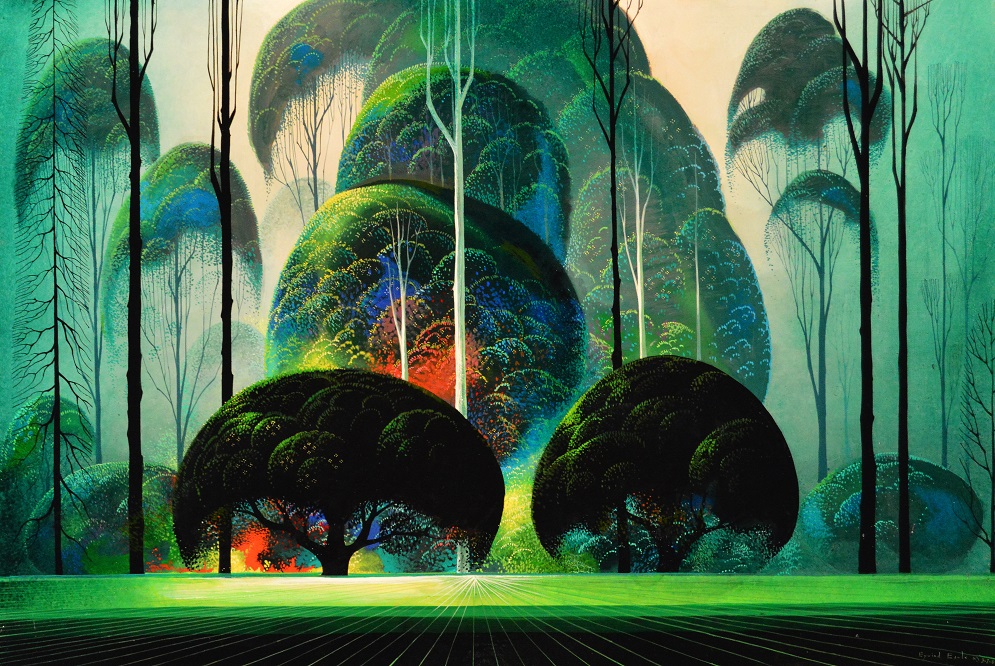
When I was a kid, I was as close as it gets to being obsessed with Disney’s Sleeping Beauty for two reasons; Maleficent and Eyvind Earle.
Maleficent was my favorite villain in the smaller pantheon of Disney movie characters back then. I think mostly because she was who she was without apology and without the slapstick of the likes of Hook or the ugly step-sisters. I also think I was drawn to her lack of backstory (before the release of Maleficent…which I also enjoyed despite the removal of the mystique). She didn’t want to be the prettiest. She didn’t want to secure her place in society. She was just bad cuz she was bad. My little self also grew to really love the dryness of her sense of humor. For a character with no clear motivations, she was pretty fascinating.

And Eyvind Earle? Who was he in the movie? He actually isn’t a character. He’s the illustrator who gave the artistic vision and style to the movie. And what a style!

Earle’s images are so full of lush, whimsical, moody atmosphere. Growing up in the thick, moss soaked trees of Florida, I could understand the love song Earle composed to forests. Not to sound crunchy, but everyone should dance/play/read/snuggle under a live oak at least once in their life. The way those trees create defined spaces within a forest is nothing short of magic.
I wanted to live in that forest. I still do. It was eternally spring there. His use of simple shapes to contrast different trees and flowers was right up there with the likes of Charley Harper!
I think Cornus angustata syn elliptica would fit into Eyvind’s imagined world quite easy, even if it is mouthful to say.
In fairness, you don’t have to say the entire name. I’m just being thorough. Cornus angustata is also called Cornus elliptica. Most people in the trade only call it one name: ‘Empress of China’ Dogwood.
Though there could be confusion about the name (I’m only mentioning the 2 most common classifications. This tree has been shuffled around from species to species, to subspecies and back so many times), there’s no confusion about the beauty of this tree.
Dogwoods are funny things. Here in the south, they are about as ubiquitous as our Southern Magnolia and as equally celebrate. Our native dogwood, Cornus florida blooms in the early spring before the foliage emerges (most years). Its “petals” are large, undulating, and papery on the tips of fine delicate branches. In fall, the trees wide papery foliage changes to hues of crimson, red, and orange. In early winter the fertilized flowers bare bright red berries that attract birds. The entire tree can get up to 30’ tall, but we most often see them age out at about 20’ish with a wide, umbrella like shape. They are happiest in filtered light but can adapt fine to full sun if given enough water.
Another popular dogwood is the Korean dogwood, Cornus kusa. This smaller tree has stiffer leaves and a more compact habit. Reaching about 20’ tall and 15’ wide, the kusa dogwood forgoes the early spring show for a later presentation. Kusas bloom late spring with a profusion of small white “flowers” that sit atop the foliage. These flowers fade after 3 weeks and bare small strawberry looking fruit in the fall. After the foliage turns red and drops, the little fruit hang like wee ornaments until the birds abscond with them.
There are of course many other cornus species that I could discuss, from the cornelian cherry to the flame twig varieties. But those discussions will have to happen at another time. For we are here to sing the praises of the Empress of China Dogwood.
We recently had a small group of friends over for Memorial day. The garden looked pretty darn good. The crew and I had been in it early spring and as such, most of my plants look happy and well cared for. That hard work did not go unnoticed as our friends asked me about various beauties they had not seen before. But one plant got more questions and comments than any other.

My Empress of China dogwood traveled to this home with me in a large clay pot. I had ordered it years ago from some specialty nursery and kept upsizing the pot as she grew from a wee 4” plant to about 3 feet. When we moved to our home in Ormewood Park Atlanta, I gave her what I thought would be her permanent home. A few years later, my hubs pointed at her and said ”I want that tree moved over here. I want to see more of it.” He rarely makes demands of the garden, so when he does, I oblige.
Moving her wasn’t an easy task. In native soil she had grown fast and her root system was extensive. But we managed and with a little bit of pampering she made it through.
The Virtues!
So much exposition. Get to the meat, Joshua!
Like all dogwoods, Empress of China has showy bracts. The flowers are insignificant but do attract hoards of native bees and pollinators. The real attraction for us non winged humans are the bracts (now you know why I kept putting the words petals and flowers in quotations). The first flopwer shapes start about early April. The bracts continue to grow over the course of, not days or even weeks, but months. This tree has had flowers on it for months.
Eventually, by late June, the bracts will fall like snow from a branch, creating a sweet white blanket on the ground for several days before the summer heat dries them to mulch. The fertilized flowers will begin to grow and ripen to create a fruit much like the kusa dogwood, only slightly translucent.

In the fall the leaves turn crimson and purple along the margin and then…
Well, and then they just stay there. Depending on what kind of summer and winter we have, these trees are either evergreen or semievergreen. If the summer is significantly wet and the winter mild the leaves persist into spring when new growth pushes the old growth off. If we have a dry summer and cold winter, the tree loses about 70% of the leaves, but keeps enough to provide some screening.
Empress of China gets about 20’ tall and 15’ wide. Mine is about 10’ at 10 years (but remember it was in a pot for several years and then got moved 4 years ago).
Though they prefer filtered sun, they can handle full sun with a little more water. I did give mine a camel bag this year when we went 6 weeks with no rain. But in fairness, nothing really loves going that long without water that isn’t a succulent.
I believe Empress of China does a wonderful job of extending spring into the summer. The profusion of flowers and evergreen foliage reminds me that some cycles are longer than the seasons we are so used to. They remind me that some things persist even when we expect them to be fleeting.
